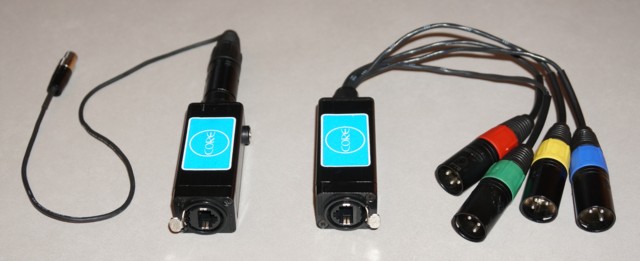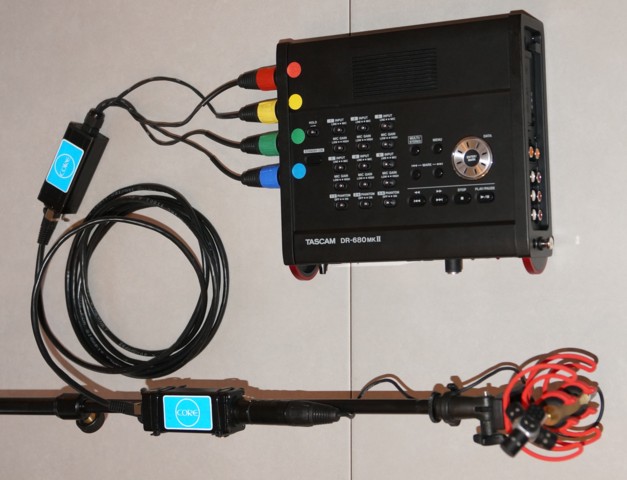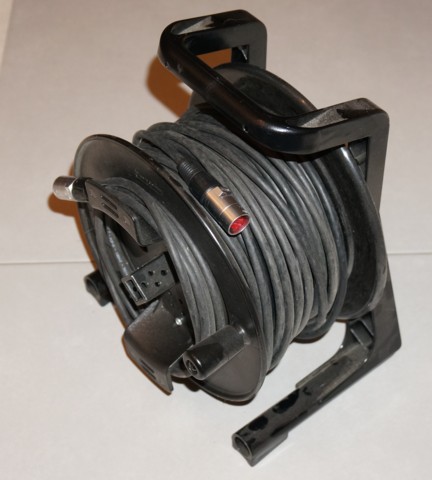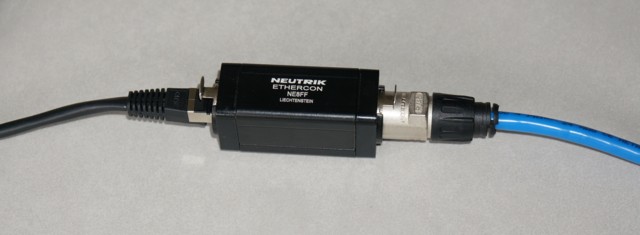PPAc Connections
The PPAc
The PPAc is a recently added accessory for the TetraMic. It combines four PPAs into a single small box which is connected to the mic by a single short cable, and then connected by screened Ethernet cable of any practical length to another small box which has break-out cables to four XLRs. The boxes will accept standard Ethernet connectors, or the Neutrik Ethercon connectors (which have an XLR-like outer housing). The boxes look like this:

and are connected like this:

Note that the XLRs come with those coloured collars (new ones are also tagged with channel numbers, though mine isn't). The colours match those used by Soundfield (Lf=1=Red, Rf=2=Yellow, Lb=3=Green, Rb=4=Blue), which some other people decided to agree to use after a discussion on the Sursound mailing list some years ago. I have put matching colour stickers on my recorders for fast and foolproof setting up. The box near the microphone I attach to the stand with nylon ties, insulating tape, or velcro strips, depending on what comes to hand:

I dare say that it would be acceptable in most circumstances to use the 6 foot or 10 foot extension cable to move the PPA box further down the stand, but I'm perfectly happy with it as shown in the last picture, and the short unbalanced cable minimises the danger of noise creeping in.
The PPAs in this box preserve absolute phase, I believe, which my original PPAs did not (I think later ones did, though); they are powered by phantom power - but that requires the Ethernet cable to be screened (to provide the earth connection). There is also a connector for battery power (which you'd have to make up for yourself), and it may be that an unscreened cable could be used in that case. Of course, a screened cable is recommended anyway, though the twisted pair construction of Ethernet cable inherently gives good noise rejection.
The combination of simpler wiring and the use of Ethernet cable rather than my much thicker conventional snake makes this a clearly preferable way to connect the TetraMic in any circumstances, and means that my field recording kit now fits entirely into a rucksack, apart from the stand.
Ethernet Cable
Ethernet cable comes in several grades - Cat5, Cat5e or Cat6. These are all twisted pair, and the differences are really only significant at the frequencies of network signals, which are way beyond audio frequencies. If you have a choice, Cat6 will give even better crosstalk rejection than Cat5 or Cat5e because the spacing of the twists is required to be different for each twisted pair for precisely that reason, though this may also not really be significant.
Screening is still important though, and the screen is in any case required in this application to provide the earth connection which enables phantom power to be transmitted. Screened Ethernet cable comes with several different screen qualities, and in my experience computer suppliers are generally completely unaware of this. Core Sound themselves can supply suitable screened Ethernet cable in several lengths, or buying cable from an audio supplier (typically made up with Ethercon connectors) should ensure that it is satisfactory. When I needed a longer cable, I found that Thomann (in Germany) sell suitable cable on a reel in several lengths:

Note the Ethercon connectors on this cable, which are accepted by the PPAc boxes.
Neutrik also make a neat and very solid box for connecting Ethernet cables (with normal RJ45 or Ethercon connectors) so that cables can be extended. Unlike most extenders sold for computer use, this also connects the screens so that the earth (and thus phantom power) retains its integrity:


